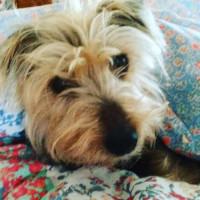Appearance of the Norkie
|
| Measuring between 20 and 25 centimeters and weighing between 2.5 and 5 kilos, the Norkie is smaller but slightly more robust than its Yorkshire Terrier relative. Their bodies are proportionate and compact, rectangular in shape and short-legged. They should have a small face with a neat muzzle and dark brown, circular eyes. Their ears are set high on their head and can be erect like Yorkies or gently drooping like Norfolk Terriers. Their nose is black and relatively large, occupying a central position on their small face. Their tail is moderately long and can be held upright or to the side. The Norkie's coat can be hard and medium-length like the Norfolk Terrier, or long and silky like the Yorkshire. In fact, most have a coat that falls somewhere in the middle of the two. When left unkempt, their coat can look quite shaggy and unkempt. Many dogs will have black and beige coats, although some have wheaten or red coats. |
Temperament of the Norkie
|
| It's typically the Norkie's personality that makes them fervent to potential owners. They rely on human companionship for their happiness and love to be surrounded by people. They are very affectionate and loving and will form close bonds with the whole family, sometimes choosing one person as a favorite. They are very happy to act as lap dogs and will never say no to a cuddle. Curious and courageous, the Norkie tackles the world at full speed and is rarely fearful or cautious. They are highly adaptable and can live well in both urban and rural environments. They are generally tolerant of children, but some dogs can be lively if handled too much, and it's always best to supervise this small breed when young children may treat them like teddy bears rather than animals. As with a number of small breeds, small dog syndrome can become a problem in the Norkie. Affected dogs can be overexcited, cheerful and often don't listen well to instructions. While they may tolerate their family, they can be unacceptable to others and may growl and lash out for no real reason. Owners must understand that, although the Norkie is small and incredibly cute, it must learn to respect the same rules as all other dogs, and that bad behavior must not be tolerated. Regular training, play and exercise can prevent this syndrome from developing. |
Needs and activities of the Norkie
|
| A real advantage of the Norkie is that it doesn't require much space or exercise. Although they are active, a vigorous 30-minute walk or hike is usually enough to satisfy them every day. Owners should supplement this short walk with a number of play sessions, and should try to keep their dog mentally engaged by offering plenty of fun and varied activities. |
Maintenance of the Norkie
|
| The Norkie's grooming requirements will depend on the parent breed it inherits, as well as on whether owners choose to keep their coat long or trim it regularly for convenience. Long, silky coats will need daily brushing to avoid tangles, while shorter coats will need brushing much less often than this. It's important that the Norkie's teeth are brushed daily to remove any plaque accumulated during the day and reduce the risk of periodontal disease. Their small jaw size means they are prone to overcrowded mouths and bad teeth. Owners can also maintain healthy teeth by eating dry kibble rather than wet, meaty diets. |









 English (United Kingdom)
English (United Kingdom)